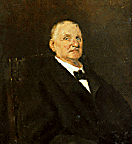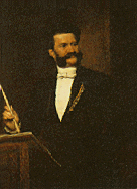Music History 102:
The Late Romantics
By the middle of the nineteenth-century, the cult of the composer as genius, cultural icon, or artistic prophet had become a generally accepted one in European musical culture. These years saw the expansion of the symphony orchestra, from the thirty or forty players of the previous age to almost a hundred or more; the new conservatories and schools for the training of instrumental musicians led composers to demand an incredible amount of technical virtuosity from every instrumentalist in the execution of their scores; composers pursued even more color and emotion in their music by increased use of dissonance and chromaticism while shedding the constraining discipline of the Classical forms. This was an era of music of much richness, opulence, color, and flamboyance, as can be heard in the compositions of German-born Johannes Brahms, the cosmopolitan Russian composer Peter Tchaikovsky, and any of the composers of the blossoming Nationalist schools.

Anton Bruckner
Born: Ansfelden, September 4, 1824
Died: Vienna, October 11, 1896
Having spent much of his life as an organist and teacher, Bruckner went to Vienna in 1867 to teach organ and music theory at the Conservatory there. It was then, quite late in his life, that he turned to composition, writing much sacred choral music and nine massive symphonies, leaving the last unfinished at the time of his death. Bruckner’s small-town, peasant background, his deep commitment to the Catholic faith, and his worship of the music of Richard Wagner, are all integral components of his musical style. His nine symphonies, for which he remains best known, combine Wagnerian harmony and orchestration (with a decided emphasis on the orchestra brass) with simple, song-like melodies and a deeply-felt, spiritual fervour. His most popular symphonies are probably the Seventh, the unfinished Ninth, and the “Romantic” Symphony no. 4.
French Music of the late nineteenth century

Camille Saint-Saëns
Born: Paris, October 9, 1835
Died: Algiers, December 16, 1921
Described by a famous conductor as “the best second-rate composer in history,” Saint-Saëns was nevertheless an excellent craftsman and exceptionally skilled in the art of orchestration. An outstanding pianist and organist and a prolific composer, only a handful of his compositions are now generally well-known. These include a few concertos, several tone-poems (such as the famous Danse macabre), his biblical opera Samson et Dalila (which is more oratorio than opera), the ever-popular suite known as The Carnival of the Animals (which Saint-Saëns wrote for a group of friends and never intended to have published), and the beautiful and majestic “Organ” Symphony no. 3 in C minor. During his lifetime, Saint-Saëns was a respected and influential musician in France, and he taught, performed, wrote books, plays and poetry, and even dabbled in the sciences. Early in his career he was proponent of “new music,” doing much to further the careers of Liszt and Wagner. In 1871 he co-founded the Société National de Musique for the encouragement of French composers. Ironically, the extreme musical conservatisim he cultivated in his later years caused him to despise the music being written by such French composers as César Franck (1822-1890), Jules Massenet (1842-1912) and Claude Debussy.

Georges Bizet
Born: Paris, October 25, 1838
Died: Bougival, June 3, 1875
The son of professional musicians and having entered the Paris Conservatory at the age of nine, it certainly seemed that Bizet was destined for great things in music. Sadly, it was not to be, for his music and operas received little critical acclaim during his lifetime. He is, nevertheless, the composer of one of the greatest operas in the international repertoire, Carmen. Yet this, too, was not successful at its premiere, and Bizet died only three months afterward. But the opera continued to play, slowly finding an audience. The score’s instrumental color, abundance of wonderful melodies, tense drama, and vibrant characters have ensured its continued success in the world’s opera houses. As were many French composers of the time, Bizet was fascinated by the sights and sounds of Spain, and the Spanish setting of his masterpiece allowed him to create such wonderful musical numbers as this chorus from Act IV of Carmen, in which the excited crowd cheers the approach of the famous toreador, Escamillo.

Johann Strauss, Jr.
Born: Vienna, October 25, 1825
Died: Vienna, June 3, 1899
During the middle and later years of the nineteenth-century, a style of “light” music became popular with the European middle classes. By appealing to a less-refined, less-discriminating taste for melody, harmony and rhythm, many composers found their audiences in the music halls or on the dance floors: the racy can-can and galop enlivened the parodistic opera-bouffes of Jacques Offenbach (1819-1880); the Victorian sentiment, melody, and satirical humor of the operas of Gilbert and Arthur Sullivan (1842-1900); and in Vienna, the dance music of the Strauss family. Known as “the Waltz King” for his hundreds of waltzes, Johann Strauss, Jr. was a violinist and orchestra leader who also wrote a great number of dances other than waltzes, such as polkas, galops, and quadrilles. Many of Strauss’ melodies are instantaneously familiar the world over, such as Tales from the Vienna Woods. Strauss also composed a number of frothy Viennese operettas, the best of which is Die Fledermaus.
Music History 102: a Guide to Western Composers and their music
Designed, compiled and created by
Robert Sherrane